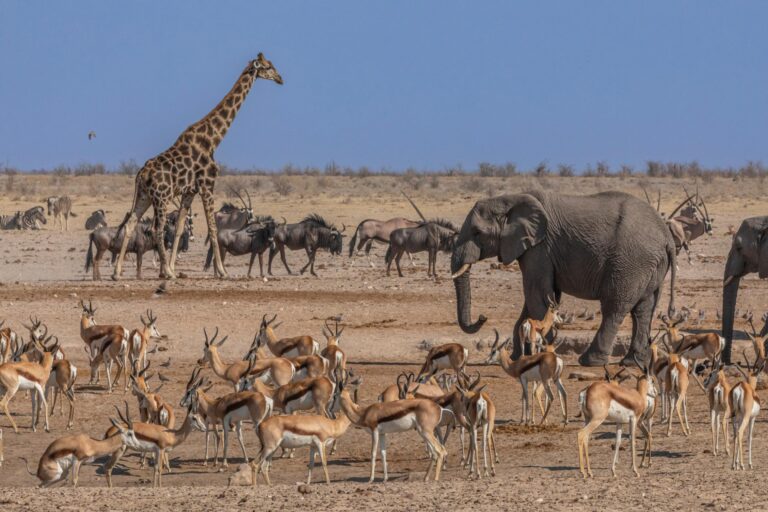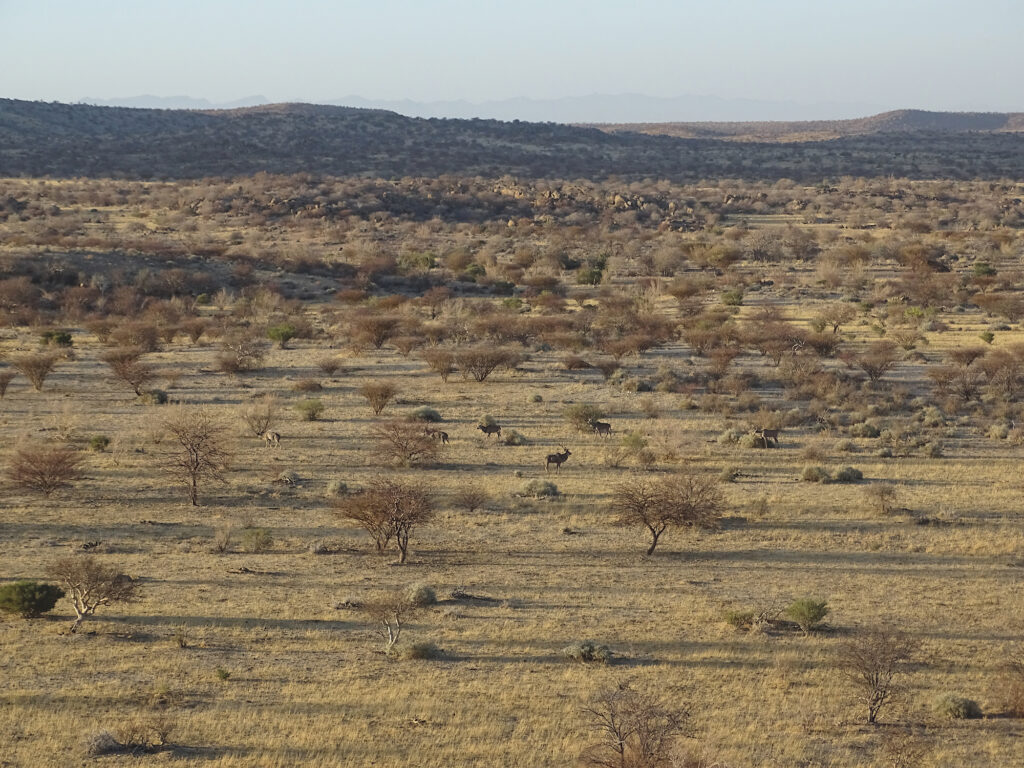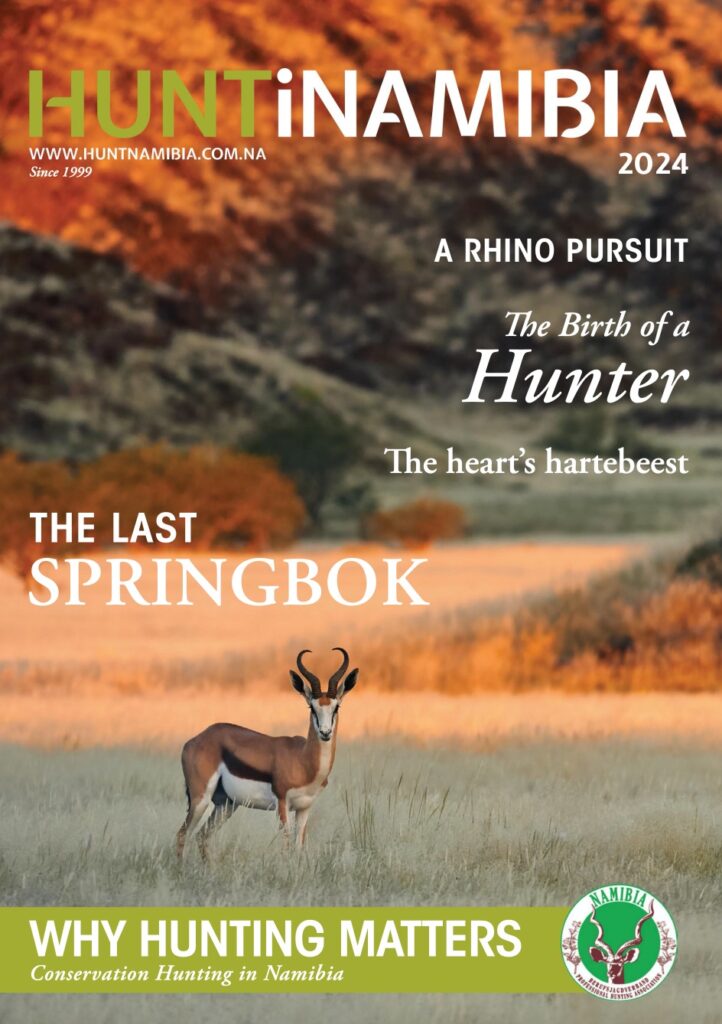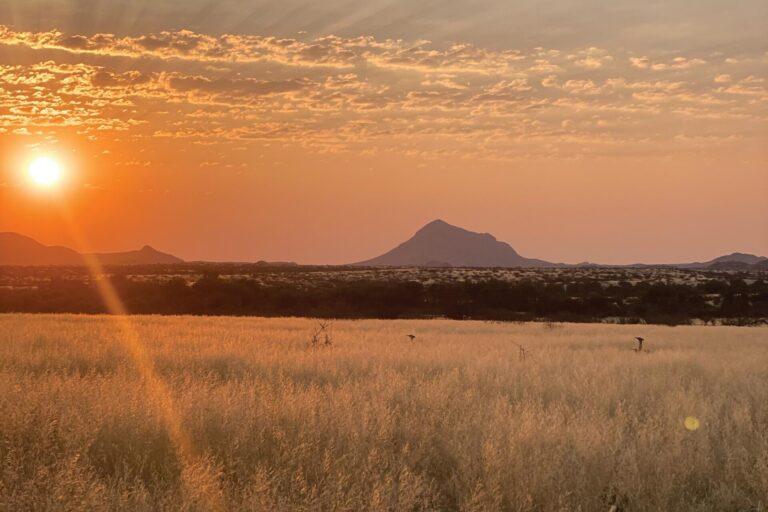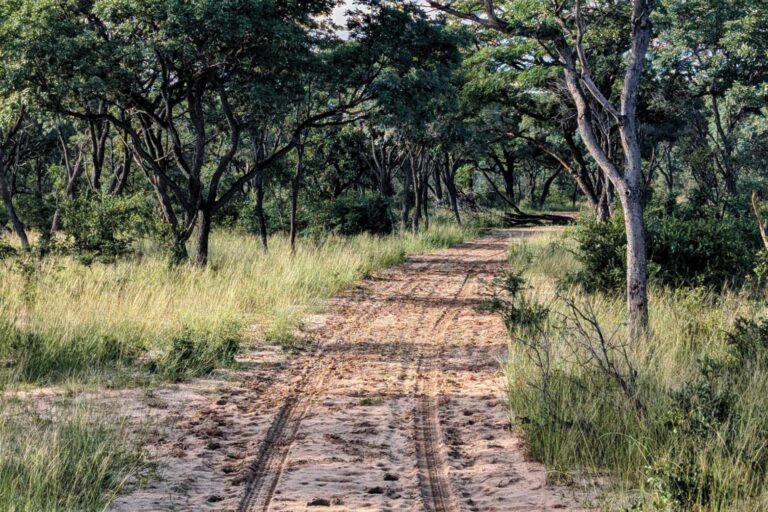Personally, I have a different take on this: not an individual animal or species is what gives value and reason to hunting, but nature as a whole. And pristine nature at that.
Conservation cannot merely be justified and defined by a headcount of the number of game animals present at a place. Conservation must look at the health of nature and the originality – for lack of a better word – of nature, how each species has its place in a habitat and plays its role in the life cycle of an ecosystem.
Hunting – and the financials that inadvertently come with it – should be about the experience, about experiencing nature in all its layers. From a very early stage in my career I personally had difficulty to “hunt for money”. A considerable portion of the revenue from a hunting safari is traditionally made with trophy fees. If things get tight towards the end of a safari, one may get into a moral dilemma if it happens that an animal is “talked older than it is” to justify shooting it to collect the much needed trophy fee – and yes, I am not innocent of having done this. I have, however, developed a mindset over the years and especially since I started hunting on my own account. I promised myself that I would endeavour to only hunt an animal that actually is past its prime and has had the chance to pass on its genes.
Very recently I dropped two hunters (a married couple) at the airport for their flight back home. I always accompany my hunters until all their luggage is checked in and all is in order with their firearms. While Thomas was taking care of the paperwork for the firearms I waited outside the office with Brigitte. I overheard how the friendly police officer enquired how many shots Thomas fired over the course of the 10-day hunt with me, as he seemed to suspect an error in the number Thomas had entered in the form. I was called into the office and the police officer asked me whether Thomas and his wife hunted with me and if they really only fired three shots. I confirmed that. “What did they shoot?” – “Only one springbok” – “Only one springbok?!” – “Yes”, I said. “Very good hunters and a very good shot”. The police officer had to take my word for it and cleared the rifles for the flight back.
What may sound like a very unsuccessful hunt to most hunters, was probably one of the best safaris I have ever guided. Thomas and Brigitte had booked an all-inclusive hunt with me, with the possibility of bagging a kudu (Thomas) and a springbok (Brigitte) as their preferred quarry. They paid for the experience to hunt with me in this arid area, with low but stable game populations that fluctuate with the seasons and the long-term conditions of the veld. I conduct my hunts from a simple tented camp on the banks of a smallish dry riverbed overlooking the Erongo Mountain panorama. The hunting area is a magnificently diverse piece of land, ranging from granite boulder mountains and rolling rocky hills to hauntingly beautiful fossil flood plains, interspersed with small granite outcrops – koppies – along big dry riverbeds with their lush forest-like vegetation, meandering south-westwards through the ancient pristine surroundings.
We were primarily looking for an old kudu bull – I only hunt individuals that are truly past their prime – and spent the ten hunting days exploring almost every corner of the hunting area.
Our first kudu, and our first kudu bull, we saw on the third hunting day: a prime bull at the height of its existence, coming down to the majestic Khan River with his harem to feed on the dropping pods of the ana tree. It was a truly big bull. He would have been hunted on any other hunt, but I explained to Thomas that this bull still needs to pass his genes on for another two years or so. Thomas accepted this and agreed without a second thought. We watched the herd of kudu slowly making their way along the riverbed. When they disappeared under the large canopy of ana, leadwood and umbrella thorn, we continued our search for the old one.
The following days saw us in the farthest corners of the hunting area, at times glassing from some high peaks, in cold and uncomfortable drizzle rain, without catching as much as a glimpse of an animal, let alone a kudu. At other times we spent our days in rocky outcrops overlooking vast areas, observing giraffe, gemsbok, springbok, Hartmann’s mountain zebra and also kudu. But as we were still early in the rut, mostly the younger bulls were fighting for the attention of the cows, while the mature kudu bulls still kept well hidden. We found many skulls and horns of kudu in altitudes that would seem inaccessible to any kudu, but the grey ghost – truly giving merit to its nickname – did not make an appearance.
Thomas and Brigitte kept their spirits high and enjoyed every moment out in the bush. Despite our best efforts we were unable to find a suitable bull, and on the last evening in the last light we made an approach on a group of springbok rams. Thomas was lucky enough to bag an old ram. Thomas’ words, although he had successfully hunted in Namibia before, were: “maybe one should start small”.
Upon farewell they told me that they had had the best time of their lives and were overwhelmed by the experience, by nature and by the way of hunting. They couldn’t imagine hunting any other way anymore.
This is why hunting matters.
On a previous safari some years ago, when I was still hunting on my father’s property in the Erongo Mountains, I guided a 72-year-old Swiss hunter who had always dreamt about hunting kudu in the mountains over open sights. He was physically very fit and tough as nails. He never complained and only had positive words to spare, even after losing his footing in loose rubble or getting caught up in thorn trees in pitch-black darkness descending from high mountains towards the hunting truck in the evening.
Somewhere around the 5th day we had seen a suitable kudu bull from the distance but were not able to catch up with him and his harem before they disappeared in thick brush. We now searched for this bull over the next days – with a scenic break to a different area every now and then – but simply could not find him again. On the 11th and last day of the safari we were up above the area where we had seen him before and looked across a rugged plateau in front of us. After a couple of hours of unsuccessful glassing we decided to have a look beyond the plateau behind the ridge there, but to no avail. We decided to return home when I saw a curious shape underneath a scraggly tree in the middle of the plateau quite some distance to the east. One look through the binos confirmed: ‘our bull’! The bull and his harem were under a rocky outcrop, but we could not use this outcrop for an approach as a strong east wind was blowing, which would give us away immediately.
We decided to circle around the kudus and position ourselves south of them in the hope that they would move past us towards the waterhole at the foot of the plateau mountain.
We made ourselves comfortable on a granite bank some 330 yards from the kudus, who had in fact moved a little closer to where we were now. But of course they were still way too far for a shot over open sights, especially with a strong side wind.
The kudus didn’t move further until early afternoon and we eventually decided – considering that it was the last hunting day – to slowly make an approach on them, hoping that the strong wind would swallow any sounds we would make. Amazingly, after a slow, low-crouched stalk we were within excellent shooting distance of the old bull. We just had to take one or two steps to the left, to get a clear view of him. Said and done, rifle at the ready we inched leftwards. The kudu bull stood angled away from us, looking in our direction – what a sight, what an animal! For a few moments we were able to enjoy this sight before the whole herd bolted off and in no time disappeared over the ridge in the distance. The hunter had not wanted to risk such an angled shot, and now we had a long hike down the mountain before us, even more of a feat when all the tension has left the body.
But also in this case the hunter was content with how things had turned out. Although he undeniably would have liked to bag a kudu bull, he treasured the experience and the time shared hunting.
This is why hunting matters.
Lastly, I would like to relate another story of a kudu hunt I guided in the Erongo Mountains – this time a successful one. My hunter, Mike from the US, had hunted in South Africa and Namibia before with a big outfit but was never truly happy and satisfied with the hunting experience. I had already been in contact with him for a few years until he eventually booked a hunt. During our safari he often reminisced about his previous hunts in Africa and told me of a day where he was hunting for kudu in the northwest of the country. The hunting party was driving around in the hunting concession when they spotted a herd of kudu half-way up a mountain. As there was a decent-looking bull with the herd, Mike suggested stalking up the mountain to take a closer look. To his disappointment the hunting guide replied that the kudus were too far up the mountain and they could not go up there. What a different experience Mike was going to have in the Erongo Mountains!
He wanted to bag a kudu bull of 53” or more, but more importantly to him was the how and that the bull would have to be past prime. The safari took place in late May, but the first cold spell of the year had not moved in yet. It was still quite warm, making for an added challenge here in the mountains, especially since we scaled almost every possible peak during the course of the 10-day safari.
On the second day we happened upon a huge kudu bull (around the 60” mark). We were relatively close and could observe him for quite a while. I still vividly remember the day: it was one of those autumn days where the veld has changed colour already, the different hues of green make for an exceptional setting and the weather is beautifully mild. A long-tailed paradise whydah was doing a late aerial dance above as the kudu bull slowly moved along and up a mountain. He was just about in his prime, too young to hunt. We enjoyed the sight and let him pass.
A few days later we had a very exhausting morning, unsuccessfully in search of our quarry high up in the mountains. When we reached the truck in the afternoon, Mike exclaimed that this had been one of his toughest and most beautiful days hunting. For days like these, I hunt.
Towards the end of the safari, we went on an extensive hike to one of the most remote places in the hunting area, usually an excellent kudu area if all else fails. We didn’t see a single kudu all day until late in the afternoon when I spotted a herd a great distance away in another remote valley. It was very late but I at least wanted to try and get a closer look and confirm that a bull was with the group. We made it to the edge of the deep valley and found the kudus again on the far end on a steep slope. The sun was fast approaching the horizon and it was very difficult to make out and judge anything on the slope which was already covered in deep shade. There was a bull with the herd, but except for seeming to have a robust stature I could not say anything more. As darkness fell, we made our difficult return through the rugged mountainscape down to the hunting vehicle.
As I had developed what later turned out to be a very painful shin splint, we took it easier the next day. On the last day of the safari we were out early in the morning on the rim of the deep valley where we had seen the kudus before. On our ascent we spooked an ancient kudu bull with both horns broken off after the first turn (later that year I would find his skull).
From our lookout we soon spotted a kudu herd down in the thick brush of the valley. The steep slope on which the kudu had been two days ago lay east, to our left. To our right was a massive granite mountain and we decided to climb the mountain to get closer to the kudus. After a lot of back and forth between big boulders we had a good vantage point – only to see how the kudus were moving up the opposite slope. But at least we could now properly judge them and there was indeed an old, suitable bull amongst the herd, as well as a few young satellite bulls trying to make a move. We observed the herd for a while and when we were sure that they were settled into a ravine we decided to make an approach on them. We retraced our steps past our first lookout and slowly moved up the slope in a ravine parallel to the one the kudus were in. When we were at about the level of the kudus, we stalked onto the ridge. Of course the kudus had noticed something and most of the cows had already moved across the ridge. We couldn’t see the bull but I was sure that he was still coming – and quickly put up the shooting sticks. Mike got ready. Soon the bull appeared and when he paused for a moment, the shot rang out and the bull dropped in his tracks. What a hunt and what a beautiful, old bull! On top of it, the view from here was breath-taking and awe-inspiring.
As Mike and the San hunting assistant started skinning the bull, I made my way back to the car to go and get some more helping hands to carry out all the meat. As the adrenaline and tension ebbed off, the pain in my shin returned. Every step hurt and when I made my last trip with the skull and horns in bleak moonlight, I could barely walk. Yet I was content. Hunting matters. For so many reasons.
